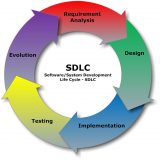Create a Business Plan in Just 9 Steps
by Olivia Wami · Published · Updated
Are you currently in a position where your business might use a little financial boost? Do you intend to look for funding? Then, the execution of a business plan can be your best course of action, especially if you have investors in mind.
Every business needs a well-thought-out strategy to succeed. A marketable strategy is essential for the success of your business, whether it is to provide guidance or attract financial experts. But how do you put together a successful plan?
In this article we will define and explain the basic business planning process to help your business move in the right direction.
What is a Business Plan?
This is a formal statement of business goals, ideas, or initiatives that is created to project and assess business requirements. More than a funding tool; it’s also a document that illuminates the future and helps you align your policies.
Typically, it should contain basic information for investment decisions. The business strategy, projected sales numbers, and product roadmap should all be included in the plan, but perhaps most significantly, it should specify how, when, and where you aim to make those sales.
Business planning is the process whereby a business’s leaders figure out the best roadmap for growth and document their plan for success.
How should you structure your business plan?
Title Page
Your business plan should have a title page, which captures the legal information of the business. That is; the registered business name, physical address, phone number, email address, date, and the business logo.
Executive Summary
This is the most important section because it summarises the operation of the entire business at a glance and is also the first piece that bankers and investors read when they open the business plan. It should describe the nature of the product or service and highlight the competitive advantage of the business. You must describe the business’s niche concept and how it drives the business to success. It should be no more than two pages. To avoid omitting any information, this section should be the last to be documented. It must be short, direct, and it must capture the reader’s attention.
Industry Overview
After finishing the executive summary, we go on to the informative phase, where you will start by clearly describing the reasons behind the project, the business opportunities, and how your product helps to fill the gap.
This section provides Information about the specific industry that the business operates. This section provides information on, main competitors, industry trends, and projected revenues. Additionally, it showcases the market share of the business and how it intends to compete with other significant competitors.
Market Analysis and Competition
The target market for the business’s product offerings is described in the market analysis section. This section describes the business’s market knowledge by demonstrating that it has already examined the current market to establish that there is sufficient demand to sustain its proposed business plan.
Today you must think about the global market. To be global, you need to have a good and clear strategy and, most importantly, be absolutely certain that the product will work in every market that you intend to target.
The demographics, geography, consumer behaviour, and market need of the target market are all covered in market analysis. The business can provide data and sources to provide an overview of the size of the target market.
A business might present the market and competitive analysis as two distinct sections or as one.
Sales and Marketing Plan
Now that we have our product, how do we intend to market it? The sales and marketing plan details the business plans for selling its products to the target market (While one involves bringing the product to the market, the other describes how the deal is closed). It tries to explain the business’s unique selling proposition – USP, and the distribution channels it would employ to market its products and services. It includes information on the business’s price strategy, sales and distribution strategies, and after-sales service.
It’s a good idea to think about questions like:
- For what and how much will I sell?
- If my market is B2C, how will I get my product to the final consumer?
- Will it be through the internet, a store, a sales force, etc.?
- What marketing techniques will I employ?
- How do I deal with my competition?
- How much will it cost? and
- What is the likely return?
Management Plan
The management plan describes the management team, legal structure, and internal and external human resource requirements. Both the planned workforce size and the remuneration that will be provided to each employee should be specified.
External consultants such as advisors, valuers, architects, and lawyers required by the business should also be included. The executive team and advisory board members should be listed in the business plan if the business intends to seek funds from investors.
Operating Plan
The operating plan provides an assessment of the business’s physical needs, including office space, equipment, workers, supplies, and inventory. If you have the past successes to demonstrate that this is not simply a passing fancy, and you have the resources to handle the situation, this is where you will play your credibility and business cards.
The operations plan will be more detailed for a business that requires specialised warehouses and equipment, as opposed to, for example, a home-based consulting service. If the business plan is for a start-up that provides financial services, it will detail the technology to be used and the necessary resources.
Financial Plan
The financial plan is an important section where you should provide your sales projections, and it will often determine if the business will be able to secure the required funding from financial institutions, investors, or venture capitalists. To account for fluctuating rises and falls in profit margins, it’s important to consider the seasonality of your products (for example, you’re likely to sell more ice cream in the summer than the winter).
Your financial plan should show that the proposed business is viable and will generate enough revenue to meet its financial obligations. To convince investors that you have considered all options and are serious about this idea, you want this plan to be impenetrable. Some of the information contained in the financial plan includes a projected income statement, balance sheet, and cash flow.
Appendices and Exhibits
The final section of a business plan is the appendices and exhibits section. It contains any supplementary information that can be of interest to banks and investors or that give the business more credibility. Office/building designs, in-depth market research, information on the products/services offered, marketing materials, exceptional awards, and credit histories of the promoters are a few examples of the information that could be contained in this section.
Business Plan Template
A business plan can be important in providing structure and management objectives to a business. It can be a reference tool to keep management on track with sales goals and operational milestones.
When used properly and regularly, it can help you measure and manage what you’re working so hard to build. An IT consultant will devote all their time and resources to helping the business come up with ideas and projects that can help it grow. Here is a basic template that any business can use when developing its business plan:

Section A: Executive Summary
- Describe the mission of the business.
- Describe the products and/or services offered.
- Describe the target market and its demographics.
- Describe the market competition in the industry and how the business intends to grow its market share.
- Summarise the operational plan, including the inventory, staffing, and equipment needs.
Section B: Industry Overview
- Describe the business’s position within the industry.
- Identify the key players in the industry and the current competition.
- Indicate the target market’s demographics as well as information on the industry of operation, projected revenues, market trends, and governmental influences.
Section C: Market Analysis and Competition
- Establish your target market’s demographics, needs, and locations.
- Describe the market’s size, the number of units that potential buyers might purchase of the business’s products, and any potential market changes brought on by overall economic changes.
- Give an overview of the estimated sales volume in comparison to what the competition sells.
- Give a plan for how the business intends to compete with competitors already in the market to increase and maintain market share.
Section D: Sales and Marketing Plan
- Give a brief description of the business’s intended product offerings and USP.
- List the various advertising channels the business will employ to reach its target audience.
- Describe the method the business will use to set product prices that will enable it to turn a profit.
- Describe the delivery method and how the business’s items will be supplied to the target market.
Section E: Management Plan
- Describe the organisational structure.
- List the owners along with their shares in the business.
- List the top executives, together with their positions and remuneration.
- List any internal and external consultants that the business intends to hire, along with their compensation arrangements.
- If one is available, include a list of the advisory board’s members.
Section F: Operations Plan
- Describe the business’s location, including the need for an office and a warehouse.
- Describe the labour requirement of the business. Outline the number of employees the business needs, their roles, any necessary skill development, and their lengths of service (full-time or part-time).
Section G: Financial Plan
- Include the projected income statement, projected cash flow statement, and projected balance sheet in your description of the business’s financial projections.
Section H: Appendices and Exhibits
- Proposed office and warehouse plan.
- An overview of the target market and market research.
- Owners’ credit information.
- Awards.
- Product and/or service list.
Takeaway
A business plan is more than simply a piece of paper. It provides a comprehensive study of your business, the industry it competes in, and a road map for success based on the resources at your disposal. Unfortunately, the picture that most of us have is a bound document with 30 pages. The focus is on ‘the output’ when the real value in a business plan is the business-planning process itself. Business planning is an essential element of running any successful business, particularly given the growing uncertainty all businesses face coupled with ongoing changes in consumer behaviour.
As you can see from the above, regardless of what stage your business is at, business planning is an important task. At Bincom, you can choose any consultant to help you put these together. The simple act of creating a personalised business plan enables management to take into account all the different factors that mesh together to create the opportunity they are seeking to explore, as well as the resources required, and the key drivers needed for success.













